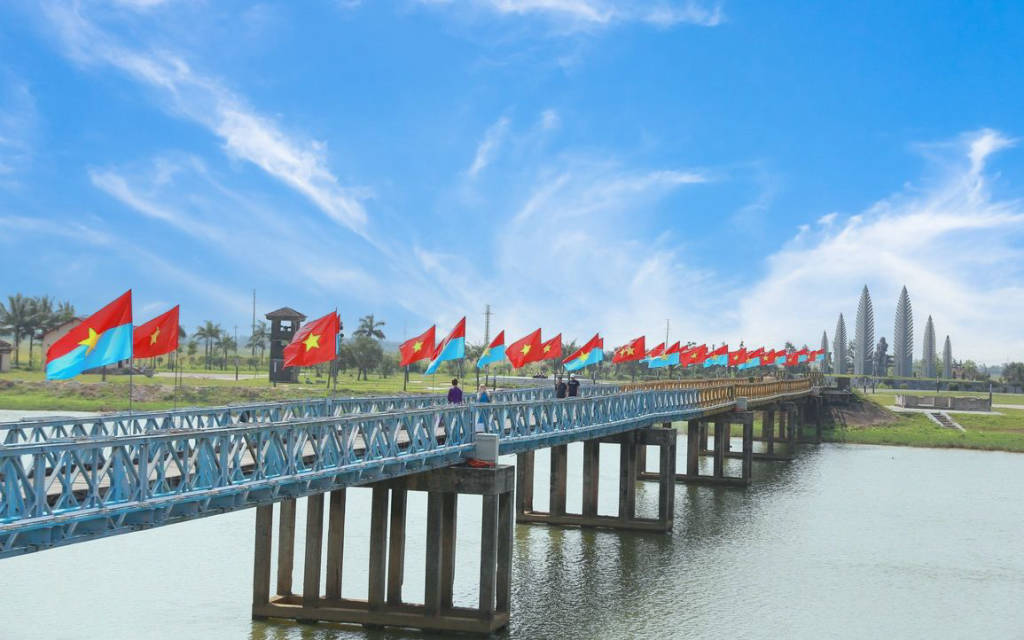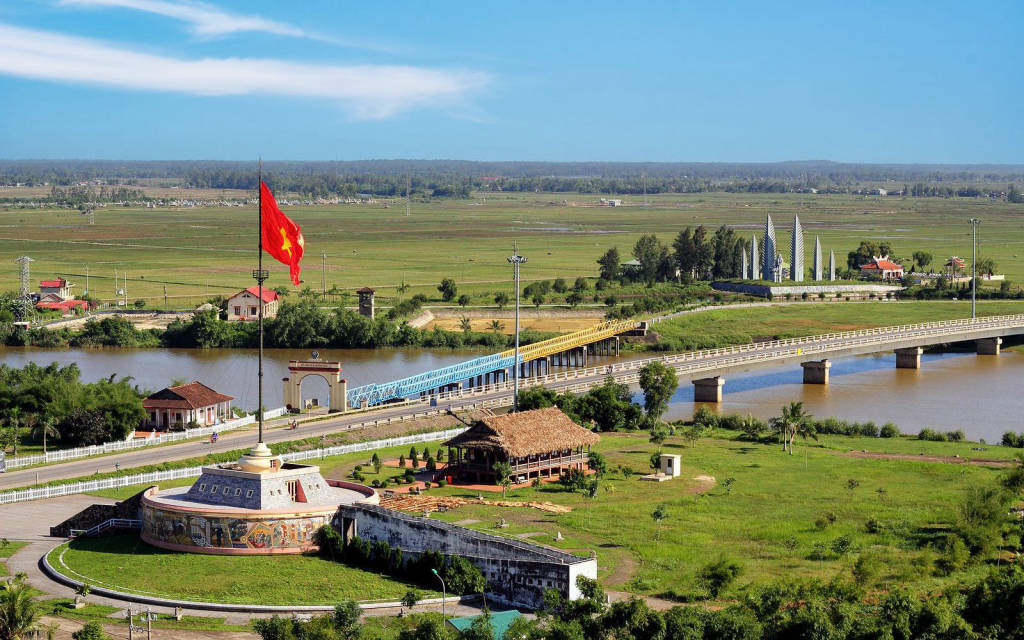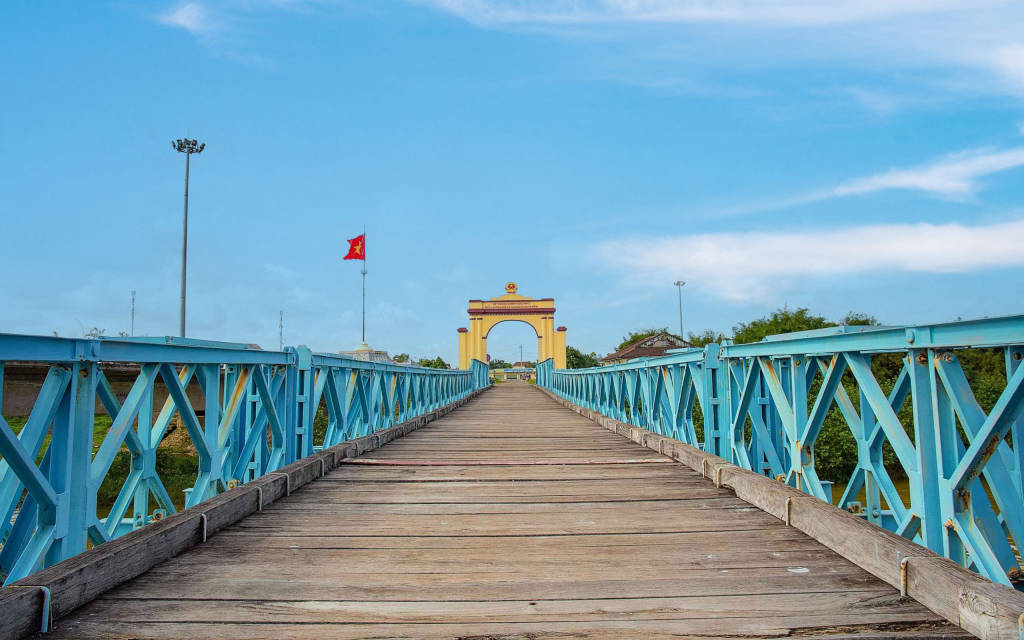Hien Luong Bridge - Ben Hai River, a famous historical relic, is a symbol of the division of the country for more than 20 years under the radical of war. This is one of the important sites along the 17th parallel, marking the division between North and South Vietnam from 1954 until the country was reunified in 1975.
1. Introduction to Ben Hai River
Ben Hai River, with a total length of nearly 100 km, serves as the natural boundary between Vinh Linh and Gio Linh districts of Quang Tri Province. The original name of the Ben Hai River was Minh Luong, but due to the feudal taboo on the word "Minh," it was changed to Hien Luong. This river originates from the Truong Son mountain range, flows along the 17th parallel, and empties into the sea at Cua Tung.
The 17th parallel and Ben Hai River became the dividing line of our country in the Geneva Accords of 1954, where Vietnam was temporarily divided into two regions, with Ben Hai River as the boundary. The pain of separation affects not only families but also leaves a deep wound in the soul of the entire nation.
2. History of Hien Luong Bridge
Hien Luong Bridge is located on National Highway 1A, in Hien Thanh Commune, Vinh Linh District, connecting the two banks of the Ben Hai River. The bridge was first built in 1928 with wood and iron piles, only about 2 meters wide, just enough for pedestrians. Over time, the bridge was upgraded multiple times, from repairs in 1931 to being rebuilt by the French with reinforced concrete in 1950, measuring 162 meters in length and having a load capacity of 10 tons.
After the Geneva Accords were signed in 1954, Hien Luong Bridge became the temporary boundary between the two parts of the country, as stipulated in the accords. The bridge was divided into two halves, each 89 meters long, painted in different colors – green for the South bank and yellow for the North bank. From July 1954 to October 1956, many touching troop meetings took place here, along with stories of families separated by the river and the bridge.
3. Heartbreaking Stories at Hien Luong Bridge
Ladies and gentlemen, standing in the middle of the bridge, we cannot help but feel the pain of separation and the resilient spirit of the nation. People on both sides of the Ben Hai River endure family separations. Many could only look at each other from afar, wave, and greet without being able to cross the bridge to reunite. Tears fell into the river, and letters sent across on small boats are unforgettable images in the minds of every Vietnamese.
4. The Struggle at Hien Luong Bridge
For more than two decades, Hien Luong Bridge was not just an ordinary bridge but a symbol of division, pain, and the desire for national reunification. Various struggles took place here:
• Color War: Hien Luong Bridge became a symbol of political conflict between two opposing governments. Initially, each side painted their half of the bridge in their own color. The Republic of Vietnam painted it green, later changing to brown, and the Democratic Republic of Vietnam immediately followed suit. This "color war" lasted until 1975 when Hien Luong Bridge became a symbol of reunification with a common green color.
• Sound War: During the period from 1954 to 1964, when the gunfire subsided, the loudspeaker propaganda war between the two sides of Ben Hai was intense. Each side uses high-powered loudspeakers to broadcast propaganda, with powerful systems and far-reaching sound, forcing people on both sides to listen to political messages from the other side.
• Flag War: From 1954, the flag war between two flagpoles on either side of Hien Luong Bridge became a national competition. Both sides continuously built higher flagpoles, hoisted larger flags, and used loudspeakers to proclaim their victories. Despite many destructions, the flagpole of the Democratic Republic of Vietnam stood resilient, continuously rebuilt after each attack.
5. Hien Luong Bridge – Ben Hai River National Historic Site
Today, Hien Luong Bridge and its surrounding area have been restored and preserved as a national historic site, honoring the sacrifices of soldiers and people during the arduous struggle for the nation's independence and freedom. The site serves not only as a tourist destination but also as a place to educate young generations about the history, the aspiration for national reunification, and the relentless struggle of our army and people against foreign invaders.
Hien Luong Bridge was restored to its original state in 2001, with the bridge measuring 182.97 meters long, consisting of 7 spans, and its deck made of ironwood. Notably, the bridge has been restored with the same blue and yellow colors as it once had in history.
6. Conclusion
The image of Hien Luong Bridge – Ben Hai River is not just a landmark on the map of Vietnam but also a vivid symbol of the nation'suffering and separation. Every plank of the bridge, every flagpole, every historical period is intertwined with the pain, loss, and the longing for reunification and unity of a nation.
As the poem says:
“Separated by a river but love remains
Sharing the same bridge but destiny is afar”
When visiting here, we cannot help but feel moved, appreciate the past, and be more determined to build a peaceful and prosperous future for the country.
 Register
RegisterSign in Travel Agent
Sign in Supplier
Sign in Affiliate
Sign in Guru







 H. Gio Linh, T. Quảng Trị, Việt Nam
H. Gio Linh, T. Quảng Trị, Việt Nam